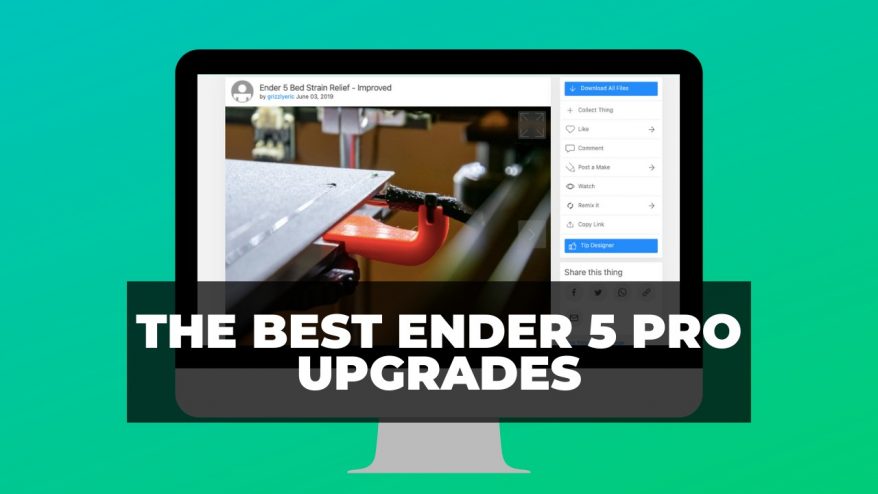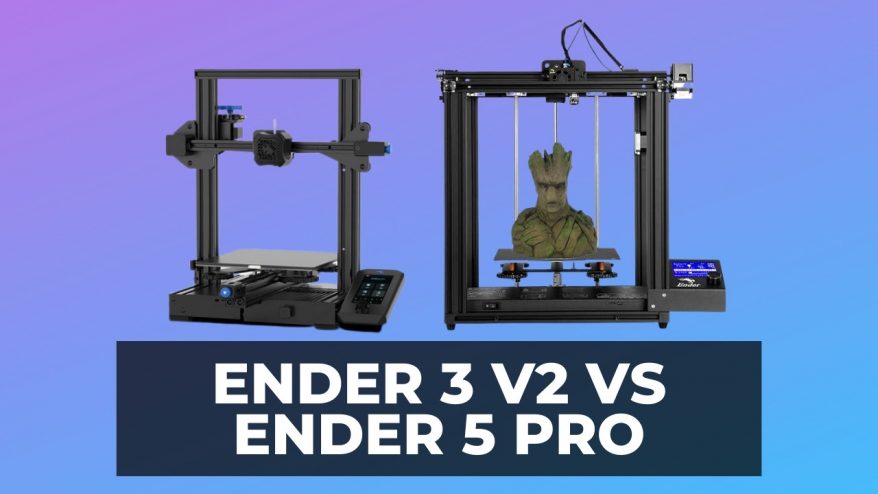
Today’s head-to-head showdown pits two of Creality’s long-standing top sellers – the Ender 3 V2 vs Ender 5 Pro, as well as a comparison to the new Ender 3 Neo.
Community favorites and consistent entries in many a top budget 3D printer list, these are two of the most popular printers around.
But what sets them apart?
The Ender 3 V2 is an easy-to-use beginner pick that is hard to beat in terms of value for money.
While the Ender 3 Neo shares many key features (like build volume and filament compatibility), it also adds some “nice-to-haves” like a glass bed and silent motherboard.
The Ender 5 Pro is a step up in terms of price and advanced features, and a better choice for more ambitious projects that require less common filaments or a larger build volume.
I’ll share my hands-on experience with each of these 3D printers, and compare all the key differences so you can make a confident choice.
So let’s work out which Ender is the best fit for your needs.
BUDGET PICK
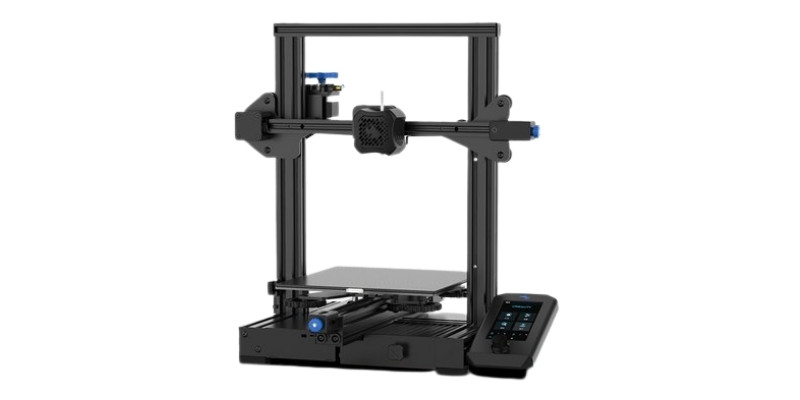
Ender 3 V2
Available at:
BUILD VOLUME PICK
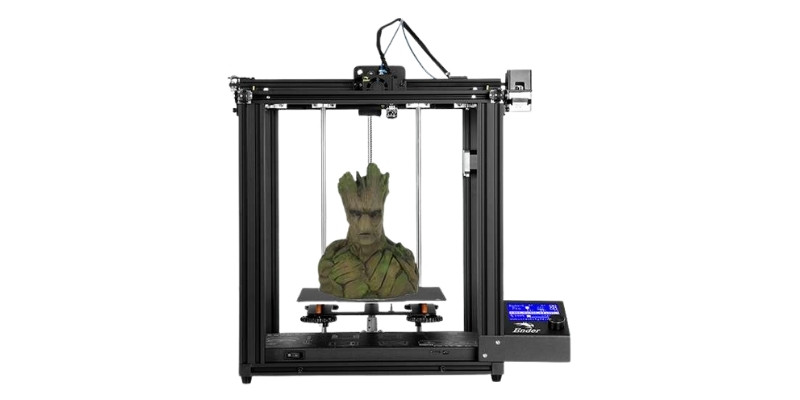
Ender 5 Pro
Available at:
3DSourced is reader-supported. When you buy through links on our site, we may earn an affiliate commission. Learn more
Meet The Printers – Creality Ender 3 V2 vs Ender 5 Pro
Ender 3 V2
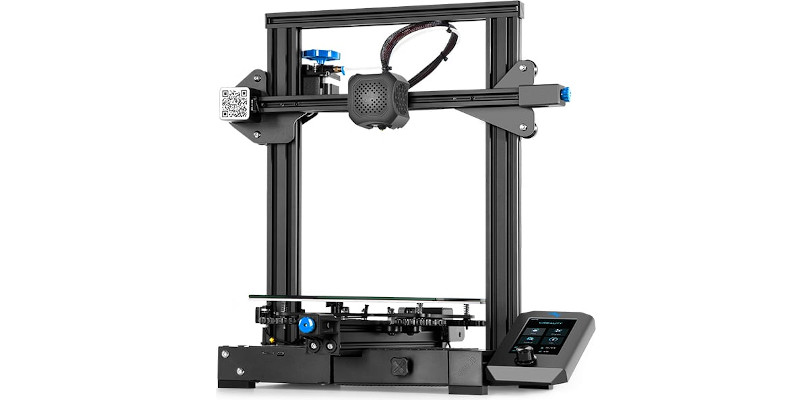
| Ender 3 V2 Specs | Values |
|---|---|
| Printing technology: | FDM |
| Build volume: | 220 x 220 x 250 mm |
| Filament compatibility: | PLA, ABS, TPU, PETG |
| Layer height: | 100-400 microns |
| Printing accuracy: | ± 0.1 mm |
| Max extruder temp: | 255°C |
| Max bed temp: | 110°C |
| Connectivity: | USB, SD Card |
Pros
Easy to use and budget-friendly.
Many good features make the Ender 3 V2 quiet and fast.
Cuts down that initial learning curve a few pegs.
Cons
The setup instructions are pretty basic and difficult for beginners.
The Ender 3 V2 matches the original Ender 3’s core easy-to-use, budget printing appeal. It injects a series of significant upgrades that, in our humble opinion, make it one of the better Ender 3 printers yet. As we know, there’s been quite a few over the years.
Looks and construction-wise, the Ender 3 V2 changes from its predecessor with a sharp, sheet metal injection and plastic panel design, doing away with the low-cost look for a more cohesive finish that gives it an extra touch of class.
On the specifications side, the Ender 3 V2 features a silent 32-bit motherboard, TMC2208 stepper motor drivers, and a tempered carborundum glass platform, a big adhesion upgrade over previous Ender 3 beds, which also speeds up bed heating.
Creality has also added various quality-of-life top-ups that make using the Ender 3 V2 a more pleasant and enjoyable printer to use long-term. These include a new, detachable 4.3-inch HD color screen, a potentially useful toolbox carved into the printer’s base, and XY-axis tensioners to easily tweak belt tension on the fly.
If you’re new to 3D printing, the Ender 3 V2 cuts down that initial learning curve a few pegs but keeps the core Ender 3 spirit of tinkering and upgrading to get the very best out of the machine. It’s an iconic printer refined, adding even more value to an already affordable machine.
Ender 5 Pro

| Ender 5 Pro Specs | Values |
|---|---|
| Printing technology: | FDM |
| Build volume: | 220 x 220 x 300 mm |
| Filament compatibility: | PLA, ABS, TPU, PETG |
| Layer height: | 100-400 microns |
| Printing accuracy: | ± 0.1 mm |
| Max extruder temp: | 260°C |
| Max bed temp: | 110°C |
| Connectivity: | USB, SD Card |
Pros
Great upgrade over the Ender 5.
Has an all-metal extruder that smoothes filament loading and extrusion consistency.
V1.15 silent mainboard with TMC2208 drivers for quieter printing compared to the Ender 5.
Cons
Relatively more expensive.
In the same way that Creality did with the jump from Ender 3 to the Ender 3 Pro and Ender 3 V2, the company bundled up the much-loved experience and features of the Ender 5 and spruced them up with some quality upgrades to create the Ender 5 Pro. This printer is very much a super-charged replacement for the original, with only a slight price jump tacked on.
So, what does the higher price tag land you? Firstly, you get the same cube frame, well-proportioned 220 x 220 x 300 mm build volume and the nippy bed heating of the original Ender 5. From there, the Ender 5 Pro pivots with a V1.15 silent mainboard with TMC2208 drivers for quieter printing compared to the Ender 5. There’s now thermal runaway protection in case things get a little too heated, too.
A much better all-metal extruder smoothes filament loading and extrusion consistency with a handy adjustable bolt to fine-tune gear pressure to suit different filament types. The Ender 5 Pro swaps the plastic tubing for brand name Capricorn Bowden PTFE tubing, raising the printer’s printing potential when fed flexible materials and cutting down on unwanted movement and other common filament loading problems.
It’s a tight set of upgrades that prove their worth from the get-go with a better printing experience than the stock Ender 5.
Ender 3 Neo
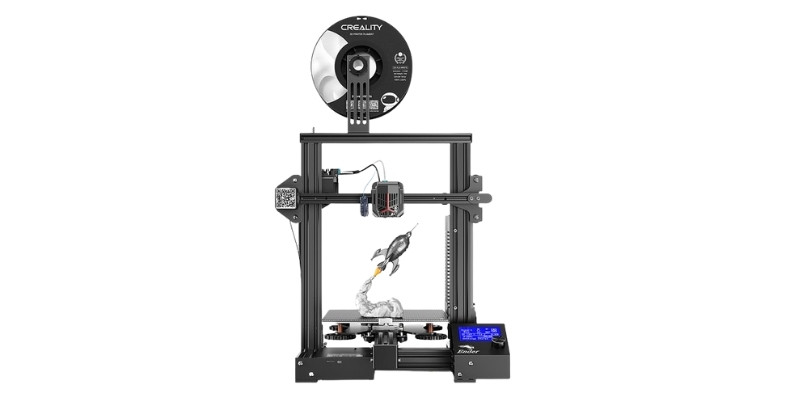
| Ender 3 Neo Specs | Values |
|---|---|
| Printing technology: | FDM |
| Build volume: | 220 x 220 x 250 mm |
| Filament compatibility: | PLA, ABS, TPU, PETG |
| Layer height: | 50-350 microns |
| Printing accuracy: | ± 0.1 mm |
| Max extruder temp: | 260° |
| Max bed temp: | 100° |
| Connectivity: | USB, SD Card |
Pros
Comes with plenty of new features.
Multiple quality of life improvements.
Benefits from a facelift, borrowing the same sharp, full-metal gantry design found on the Ender 3 S1.
Cons
Bit of a learning curve for beginners, similar to other Ender printers.
We also have to mention the recently launched Ender 3 Neo, the tenth printer to join the Ender 3 line-up.
As the Neo name implies, there are plenty of new features here. There’s automatic bed leveling courtesy of Creality’s CR Touch system, a full-metal Bowden extruder, and a flexible PC spring steel magnetic build plate.
Elsewhere, there are multiple quality-of-life improvements over the vanilla Ender 3 V2.
There’s a 32-bit mainboard (below 50 dB according to Creality, a built-in toolbox, print resume function, belt tensioners, and a new UI with a print preview function. Looks wise, the Ender 3 Neo benefits from a facelift, borrowing the same sharp, full-metal gantry design found on the Ender 3 S1.
Ender 3 V2 vs Ender 5 Pro – Head-to-Head Comparison
Build volume
Build volume determines the size of the prints you can create, so is a feature well worth mulling over before pulling out your credit card. The Ender 3 V2 has a 220 x 220 x 250 mm build volume, while the Ender 5 Pro offers a slightly larger 220 x 220 x 300 mm.
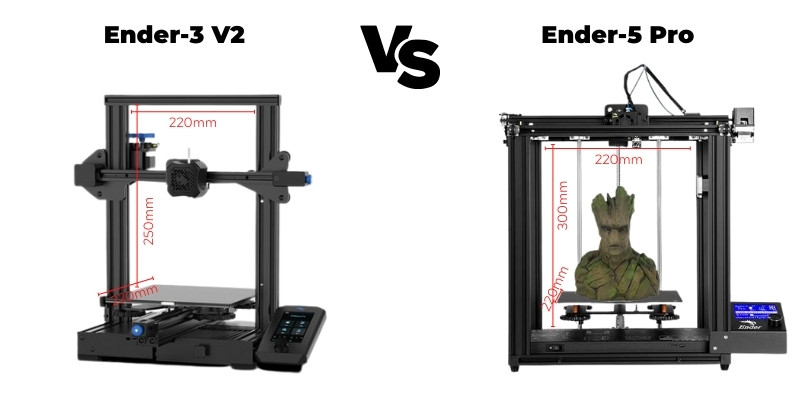
Both are what we’d consider average for entry-level 3D printers and are enough for a wide variety of projects, including decorative and displays pieces, household items, functional items, models, toys, and all those go-to Thingiverse favorites.
The Ender 5 Pro extra 50 mm on the Z-axis gives you a bit more room to print taller objects.
Max Nozzle and Bed Temperature
The Ender 3 V2 sports a maximum extruder temperature of 255°C and a maximum bed temperature of 110°C. The Ender 5 Pro features a maximum nozzle temperature of 260°C and a maximum bed temperature of 110°C.
Aside from a 5°C bump on the Ender 5 Pro nozzle temperature, the two printers are identical. Both are suited to the most common 3D printing materials – PLA, ABS (enclosure required for the best results as ABS requires a stable thermal environment), TPU, and PETG.
The Ender 5 Pro is ever so slightly more suited to more temperature-sensitive materials like nylon that require hotter nozzle temperature to print well.
As the Ender 5 Pro has a slightly larger build volume, the bed takes slightly longer to heat than on the Ender 3 V2.
As for the hot ends, you’ll find the same typical Creality parts on both machines, fed filament through a standard PTFE tube (Capricorn branded on the Ender 5 Pro) and frame-mounted extruder in normal Bowden style.
The Ender 5 Pro has a metal-extruder, which helps iron some of the more common Bowden issues such as filament jams and clogs. The Ender 3 V2 instead uses a plastic alternative, but this is easily upgraded.
If extruder and nozzle temperature are top of your list of requirements, it may be worth taking a peek at Creality’s new Ender 3 S1 Pro. With a nozzle that can reach temperatures up to 300°, the Ender 3 S1 Pro is equipped to print a broader range of materials – PLA, ABSE, PETG, Nylon, TPU, Wood fill, and numerous other high-temperature filament types.
Read more: we tested and reviewed the Ender 3 S1 Pro
Alongside, it also ships with Creality’s new proprietary Sprite full metal dual-gear direct drive extruder system that helps minimize common flexible printing issues like poor retraction, jams and clogs in the PTFE tubing, while also improving filament control and feeding.
Print Bed
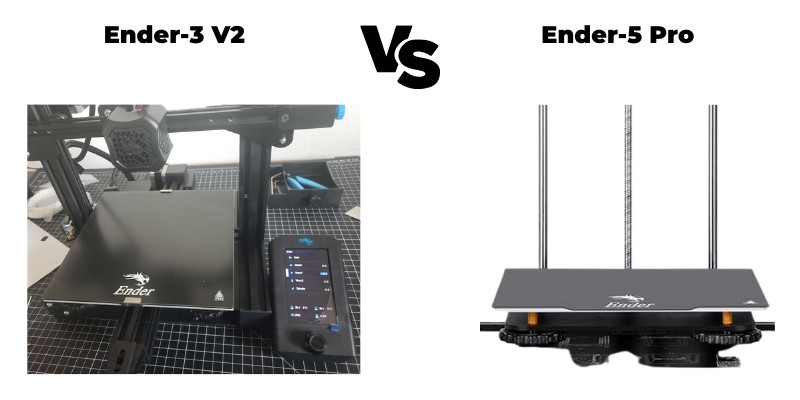
The Ender 3 V2 ships with a tempered carborundum glass bed, while the Ender 5 Pro has a classic magnetic build plate.
Each has their strengths. The magnetic bed allows for easy pop-off print removable seconds after a print finishes thanks to its flexible properties, while the glass bed on the Ender 3 V2 offers first-rate first layer adhesion and also allows prints to come off with little effort once the bed has cooled down.
On that note, both machines have heated beds, gearing them for a wider range of temperature-sensitive materials. The Ender 3 V2 can reach up to 110°C, making it slightly hotter than the Ender 5 Pro, which is capped at 100°C.
Automatic Bed Leveling
Neither machine features automatic bed leveling out of the box, so back to the time consuming task of manual calibration whichever machine you decide to buy.
Both are screaming out for an ABL upgrade, either BL Touch or CR Touch, so a worthwhile mod to make as soon as possible.
Creality seems well aware of this, which is why we’ve seen the newer Ender models, specifically the Ender 3 S1 and Neo lines-up fitted with CR Touch probes for automatic bed leveling.
Read more: the best auto-bed leveling 3D printers
Assembly
Both the Ender 3 V2 and Ender 5 Pro come in DIY, semi-assembled kits and take roughly 20-30 minutes to piece together even for first-timers.
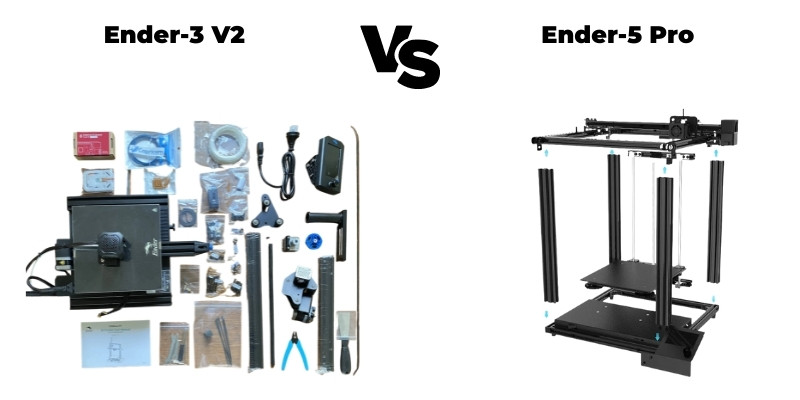
Both come with well-guided instructions and it’s a case of attaching the gantry and plugging in a few cables. The Ender 5 Pro is arguably a tad more challenging due to the design of the printer, but we’re talking an extra few minutes for most people so hardly a major difference.
Assembled, the Ender 5 Pro is a bit bigger than the Ender 3 V2 – 552 x 485 x 510 mm and 475 x 470 x 620 mm, respectively – so factor this in if you’re working with limited workshop or bedroom space.
Firmware
Both the Ender 3 V2 and Ender 5 Pro have Creality’s silent V.4.2.2 mainboards charged with the heavy lifting under the hood. As for firmware versions, the Ender 3 V2 has Marlin 2.0 pre-installed, while the Ender 5 Pro comes with Marlin 1.8.
Other than being a better all-round and quieter board than previous Creality’s electronics, the V4.2.2 also includes a bootloader, allowing you to easily upgrade the firmware. On previous Enders, upgrading required a laborious process involving a third-party single-board computer like an Arduino. This is all much easier here and both machines score points in that respect.
Price
- Ender 3 V2 – $260 – Available at Creality here / Check Amazon pricing here
- Ender 5 Pro – $399- Available at Creality here / Check Amazon pricing here
A $130 price gap separates the two machines, though we’ve seen both drop lower thanks to Creality’s love for a good sale. Given half a chance or seasonal occasion, the company systematically lowers the prices, so it’s worth waiting a little to snap up a bargain. We’ve seen the Ender 3 V2 go as low as $235 and the Ender 5 Pro down to around $330.
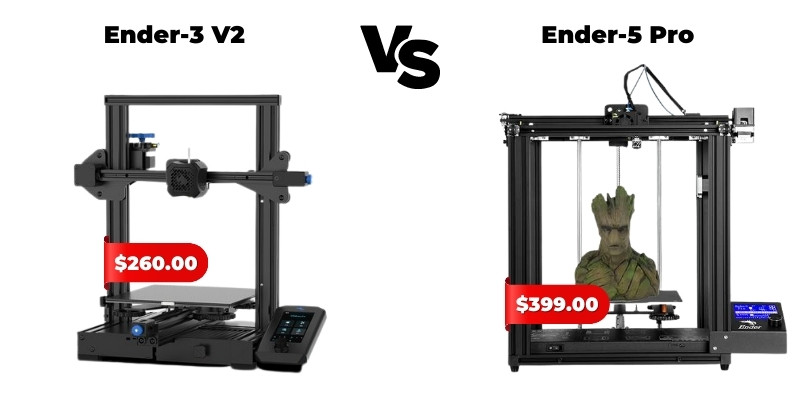
If you’re on a budget, the Ender 3 V2 makes more sense value wise, but if you need the extra build volume verticality, then the extra spend is warranted for the Ender 5 Pro. Squared up to other budget printers with similar specifications, both machines distinguish themselves as affordable picks.
Upgrade Potential
As with most Creality printers, the Ender 3 V2 and Ender 5 Pro are both upgrade-friendly devices with open designs that facilitate modification and add-ons. It’s something the Ender community has embraced, and you’ll find a huge wealth of options out there from 3D printed parts to third-party parts to improve your printer.
Whether you’re after a new extruder, hot end, tubing, nozzles, tensioners, knobs, casings, cooling systems, and so much more, there’s an option out there. For a deeper dive into what’s available, head to our dedicated Ender 3 upgrade guide and Ender 5 Pro upgrade guide.
Ender 3 V2 vs Ender 5 Pro – The Bottom Line
Which printer is right for you ultimately comes down to your needs and budget.
The Ender 3 V2 is a great starter printer that takes the basic blueprint of the popular Ender 3 and levels it up with a host of targeted improvements that make it one of the better Ender 3 options available. With so much upgrade potential, you can build on the Ender 3 V2 as your skills improve, giving it a welcome slice of future-proofing. We’d also recommend checking out the Ender 3 S1 and Ender 3 V2 Neo, as both push further down the upgrade path than the Ender 3 V2.
The Ender 5 Pro should suit those looking for a standard budget printer with a more vertical build volume to print larger prints. It has enviable upgrades, not least the metal extruder, 32-bit mainboard, and a unique design.
Both are reasonably priced 3D printers that should serve the majority of amateur makers well. As we noted above, Creality loves a sale, so look out for this with a heavy discount, which adds even more value to two already affordable machines.
BUDGET PICK

Ender 3 V2
Available at:
BUILD VOLUME PICK

Ender 5 Pro
Available at:
For the newest version, the Ender 3 V2 Neo, we recommend that you read our hands-on Ender 3 V2 Neo 3D printer view.
Related Posts:
- Ender 3 Neo vs Ender 3 V2 Neo vs Ender 3 Max Neo [Compared]
- Ender 3 V2 vs Voxelab Aquila X2 – Compared
- Creality Ender 3 vs Ender 3 Pro vs Ender 3 V2
- Ender 3 Extenders: The Best Extension Kit Upgrades
- Ender 3 Print Speed: Best Speed Settings for Ender 3 V2 & Pro
- Ender 3 Glass Bed (Pro/V2) Guide (& Best Options)
- The Best Ender 5 Pro Upgrades (Printable & Paid)
- The Best Ender 5 Enclosures (and Pro / Plus): DIY & Ready to Buy
- Ender 5 vs Ender 5 Pro vs Ender 5 Plus
- Sovol SV06 vs Ender 3 (V2 / Neo)



